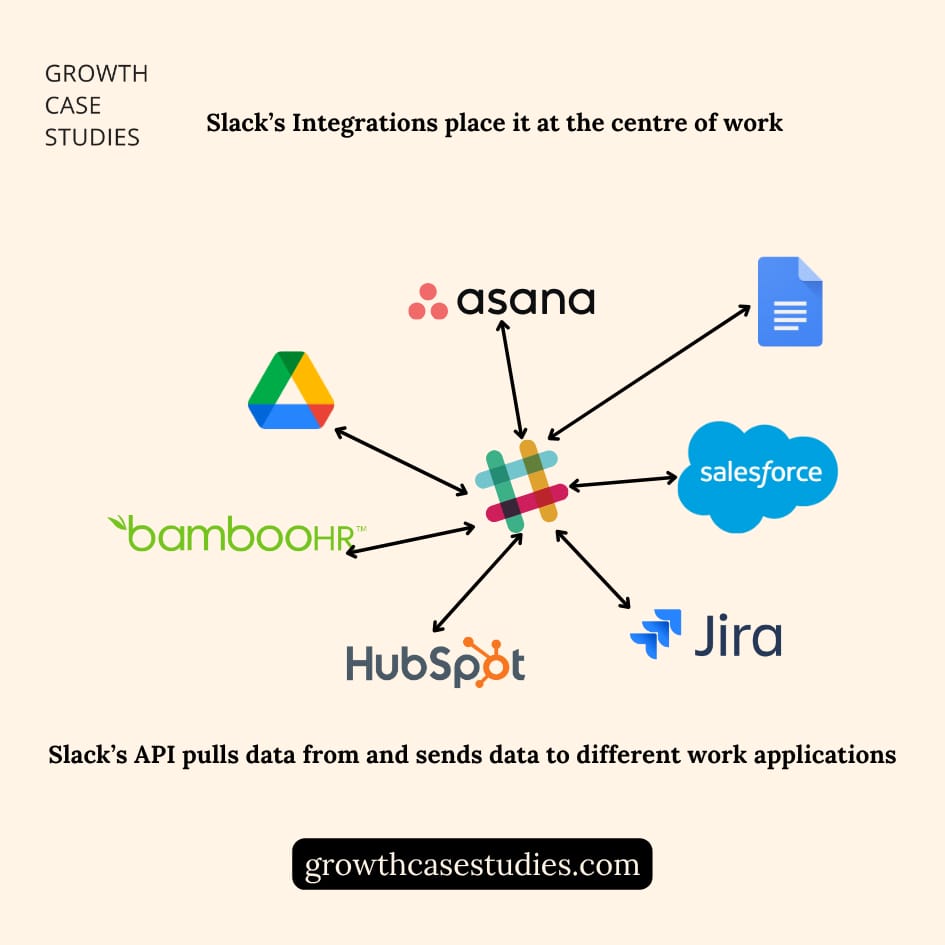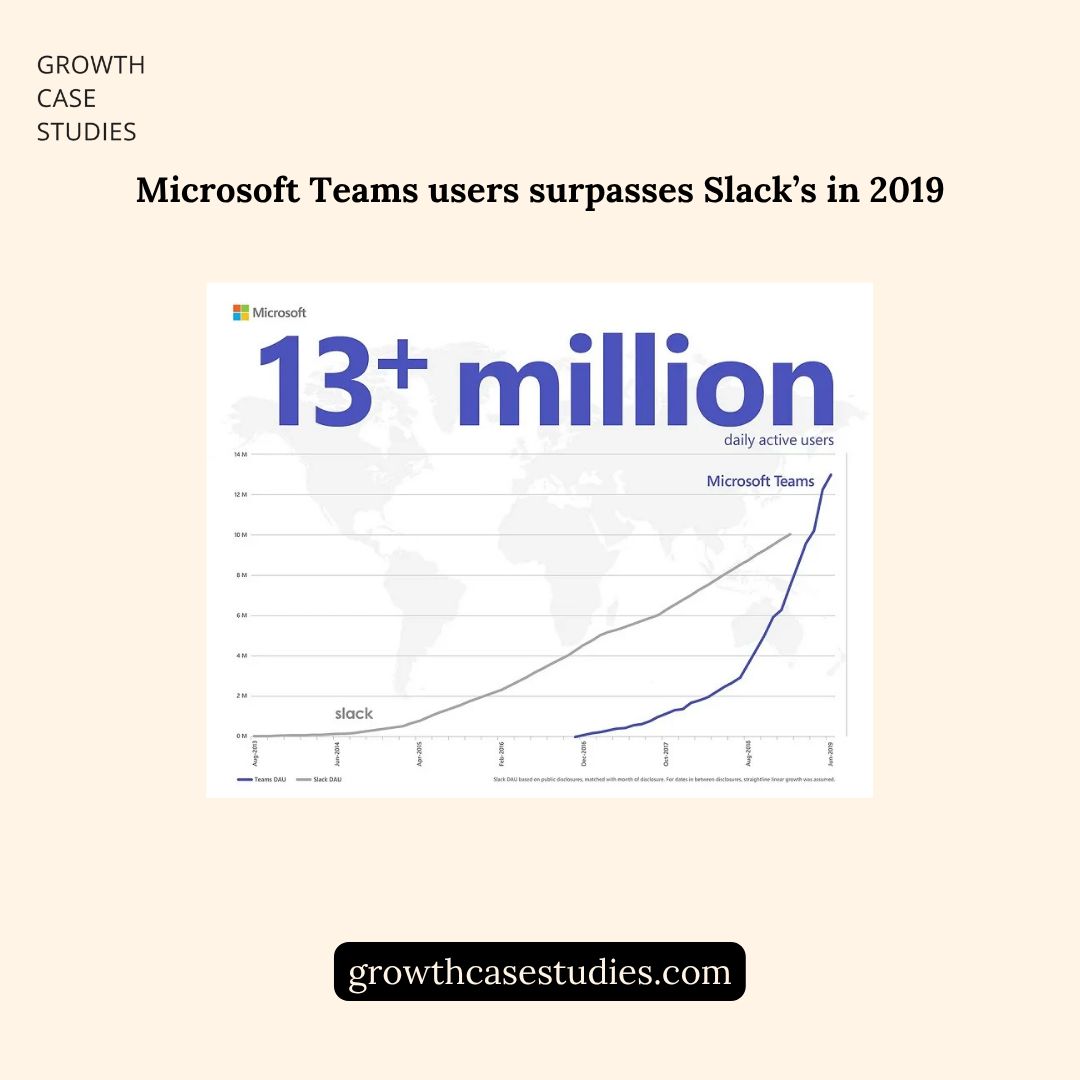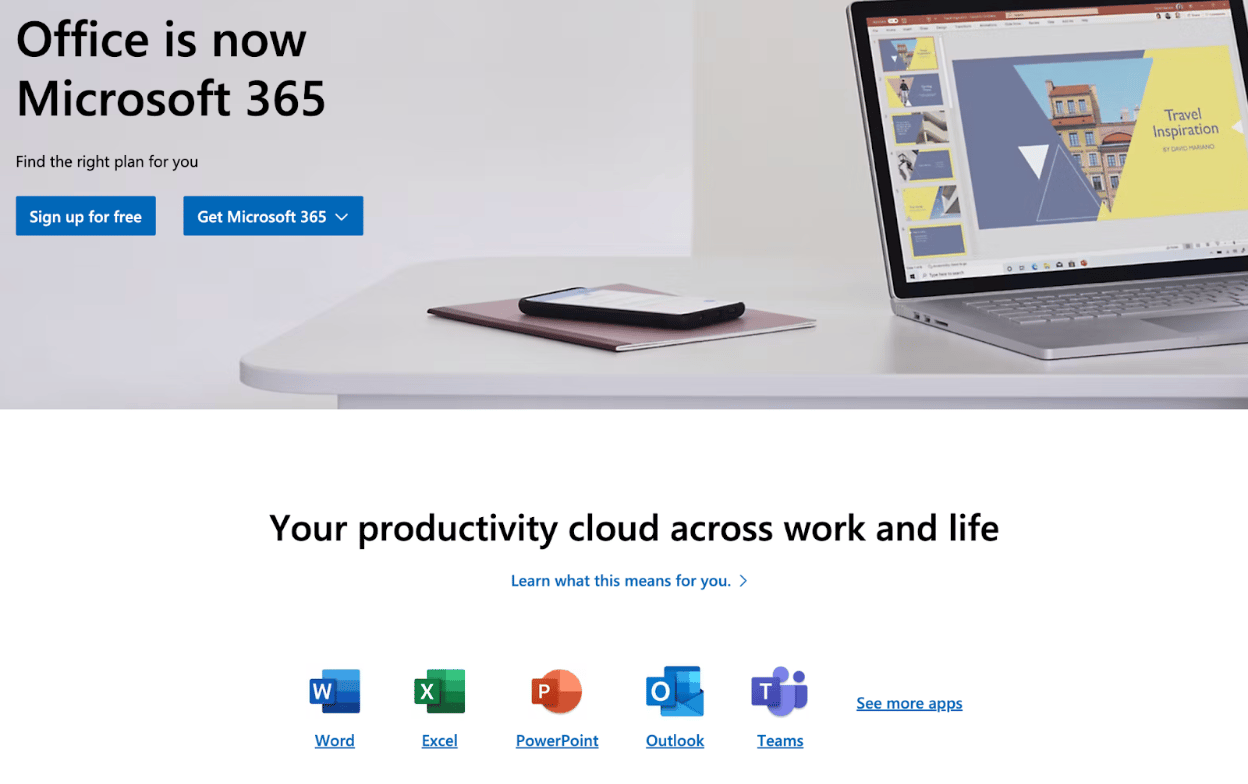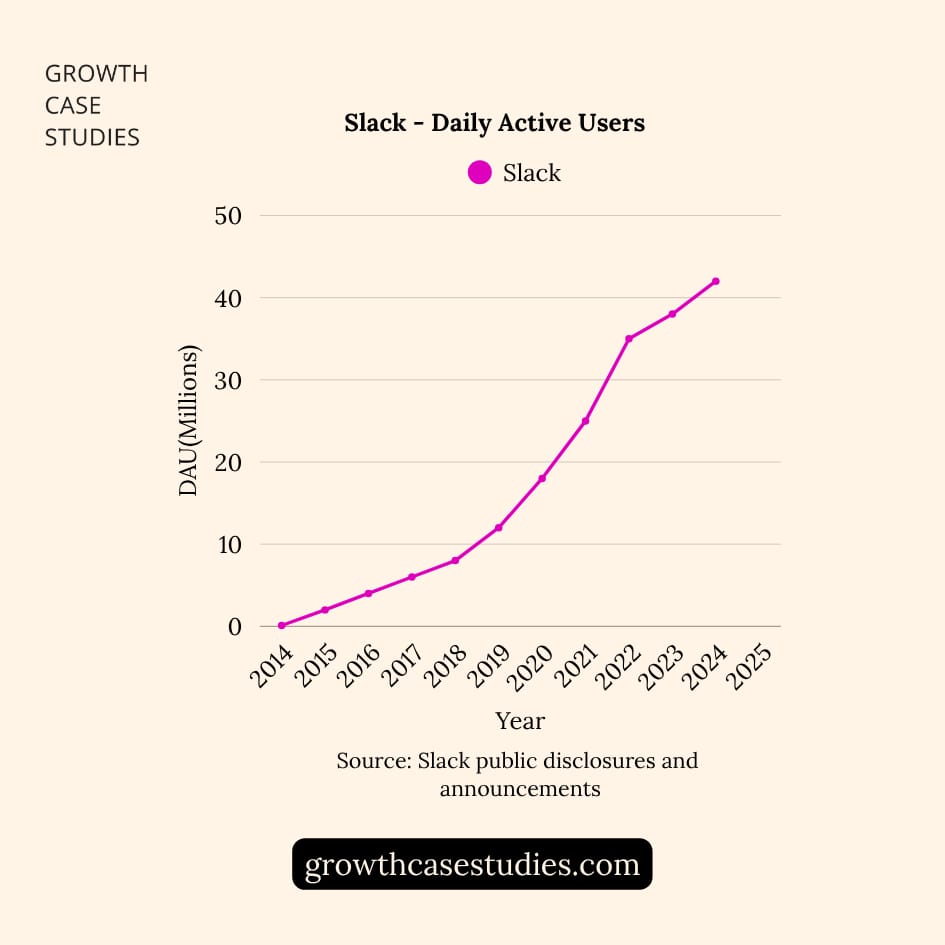- Growth Case Studies
- Posts
- Slack Vs Microsoft Teams and the battle for the Centre of Work
Slack Vs Microsoft Teams and the battle for the Centre of Work
A case study of Microsoft's network and distribution strengths, and how they helped Microsoft Teams outperform Slack, the top workplace collaboration tool.
The best marketing ideas come from marketers who live it.
That’s what this newsletter delivers.
The Marketing Millennials is a look inside what’s working right now for other marketers. No theory. No fluff. Just real insights and ideas you can actually use—from marketers who’ve been there, done that, and are sharing the playbook.
Every newsletter is written by Daniel Murray, a marketer obsessed with what goes into great marketing. Expect fresh takes, hot topics, and the kind of stuff you’ll want to steal for your next campaign.
Because marketing shouldn’t feel like guesswork. And you shouldn’t have to dig for the good stuff.
If you work in a startup, you probably know of and use Slack. Slack is a workplace communications tool that enables a company’s employees to collaborate primarily via chat. If you don’t work in a startup or work in an organisation that uses Microsoft’s Office tools, you probably know of and use Teams. Microsoft Teams is software that enables company-wide work collaboration through chat and video or audio calls.
Microsoft Teams has grown from a little-known product in 2019 to over 320 million daily active users today. While its competitor, Slack, has peaked at just around 1.1 million daily active users.
Today, we’re going to study how Microsoft’s distribution and network advantage trumped Slack.
As usual, feel free to skip sections.
Table of Contents
Slack - Founding & Origin Story
In 2011, Stewart Butterfield’s game development studio, Tiny Speck, was working on an online game called Glitch. The team working on this product needed to collaborate somehow, and since they were a software shop, they built linefeed to enable these collaborations. The first versions were on the IRC protocol and enabled the team to automate and organise file exchanges.
Before Tiny Speck, Stewart co-founded photo and video sharing site Flickr and sold it to Yahoo. Flickr launched in 2004, and by 2005, Yahoo acquired it for between $22 million and $25 million. This was during the hot social craze of the early 2000s.
By 2011, Stewart was a rare example of an exited founder, having successfully sold his startup to a respected tech giant, Yahoo. Glitch was another attempt to build a gaming company. But Glitch didn’t work out and wasn’t going to make money, so in 2012, Stewart pivoted the company to focus on “Slack,” which was derived from the phrase “Searchable Log of All Conversation and Knowledge. “ The name Slack replaced the internal name linefeed.
A common thread in this story is that both Flickr and Slack emerged from Stewart’s attempts to build gaming companies. Flickr emerged from Stewart building internal tools for his first company, Ludicorp, which wanted to make the online game Neverending. The game never launched, and the company successfully pivoted to Flickr.
Slack launched to the public in August 2013 and had 8000 businesses on its waitlist. In one of its first public appearances, it’s hinted that Slack could replace email. Hold on to that thought for a minute, we will return to email.
Microsoft Teams Origin Story
In March 2016, Microsoft executives considered an $8 billion acquisition of Slack. The company saw a boom in workplace collaboration tools, including Slack, Cisco’s Webex, Atlassian’s Hipchat, and Zoom. Since it had built digital workplace collaboration tools, it was only logical that Microsoft would want to get in on chat.
Internally, its Slack acquisition proposal would be debated for months and ultimately rejected by its founder, Bill Gates, who thought they should improve Skype for Business instead. After all, Microsoft had just acquired Skype for $8.5 billion in 2011.
Microsoft unveiled a global preview of Teams in November 2016. Its CEO, Satya Nadella, is quoted in the press release:
“At Microsoft we aim to empower every person and organization with the technology to be more productive as individuals and in groups,”
“Office 365 is the broadest toolkit and platform for creation, communication and collaboration. Microsoft Teams adds a new experience to Office 365 as the chat-based workspace designed to empower the art of teams.”
Kirk Koenigsbauer, Microsoft’s corporate vice president of Office, goes further:
“We’ve designed Office 365 to meet the unique needs of every group, with purpose-built applications — like Outlook, SharePoint and Yammer — that all naturally work together. And now with Microsoft Teams, Office 365 accommodates all workstyles,”.
Slack responded to Microsoft’s announcement with a press release, which was also published as a full-page ad in The New York Times. The release was reminiscent of Apple’s 1984 ad, following IBM's announcement of its personal computers.

Can chat replace email?
In "Why Is Notion Building Email and Calendar Features?", I posit that email is the center of modern work collaboration.
Take my workday as an example. I start my regular day every morning by checking my email and calendar. Checking these helps me think of tasks I need to complete and plan the day. When I reach my desk and turn on my work computer, I check three tools: email, calendar, and Slack. These three apps set the tone for my entire workday. Let’s take a deeper look at why email is core to work.
I go on to list email’s features and why they’re important for work. That section ends with the following quote.
These email features are why Slack tried to replace email and become the centre of work.
For anyone who worked before chat became commonplace, email was annoying. Email is so overwhelming for work that achieving inbox zero (where you have 0 unread emails) has become a global phenomenon.
Companies like Slack thought they could replace email and build a new centre of work instead. In a 2013 interview with Fast Company, Stewart makes a case for Slack and work chat.
"It’s the least efficient way to send a message, with the most cognitive overhead, If someone I worked with emailed me, I’d probably fire them."
The interview continues with a discussion of Slack’s features and Stewart’s concerns about Microsoft. This was the first time Stewart took a public jab at Microsoft. At this time, Microsoft had not launched Teams.
Then again, they should know better by now, having helped create what is meant to be an email killer. Slack presents as a main window for chatting flanked by a bar on the left offering various ways of being in touch; topmost is a list of "channels," or topics. A channel is highlighted in white when you’ve missed out on some of the chatting going on in that channel; a red number is displayed beside a channel if someone has mentioned you by name. Scroll down on the left bar and there are other ways of being in touch, including Direct Message or private groups. It’s ordered top to bottom from the least intrusive ways to communicate to the most intrusive ways to communicate, Butterfield explains.
Slack also integrates various external services, bringing all communications into one interface. So if your organization is addicted to Google Docs, Dropbox, GitHub, Crashalytics, ZenDesk, or other shared services, you can still access them all in one place. Slack doesn’t directly compete with these services, which Butterfield happily says each represent a "15-year slow-motion disintegration of Microsoft’s hegemony over the workplace." He merely wants to make all their messages "searchable, in your pocket" (and indeed, Slack runs on iOS and Android). Slack is "built around search," says Butterfield. Slack features a search bar, so you can pull up a conversation you remember from a while back using a distinctive word or phrase.
At this point in the story, Stewart is correct about the annoyance of email. Let’s take a look at Slack for a bit.
Slack’s advantage
I’ll say it in one sentence. Slack is the best workplace chat application out there. There is nothing that has come close since its public launch. If you’ve never used Slack, you wouldn’t understand until you used it. When I first used Slack in 2015, I came from a world of Skype Business, Hipchat, and Google Hangouts Chat. This new Slack, and its fun interactions, made it much better, less clunky, more useful, and a well-thought-out interface for work. Since then, it has beaten every other workplace chat tool I’ve used in terms of daily usage, functionality, and forward-thinking product features.
Since Slack originated from a gaming company, it's evident how its user-centric design is reflected in every single element as users interact with its software. Its apps are not tedious to use.
Slack has two significant advantages.
User Experience
Slack’s user experience is best described as smooth. The product simplifies work communication by creating every feature to ease this complexity. By essentially competing with email, Slack realizes that it needs to compress information to be denser yet readable, make it searchable and retrievable, and, most of all, allow multiple types of communication between colleagues, teams, and external parties.
It also chooses a wonderful colour palette that’s easy on the eyes while easing a new user into its philosophy of workplace communications.
Integrations
Slack’s biggest lever for growth is Slack Integrations. Since Slack aimed to replace email and become the central hub for all work integrations, it developed an Application Programming Interface (API) that enabled connections between the most popular work tools and Slack. Whether these tools were task management, design, document editor, cloud storage, IDE, social media scheduler, calendar, CRM, as long as the software was used at work, Slack wanted to integrate with it.

In practice, this means that Slack can connect (with permission) to a tool like Google Calendar and send its users new notifications about new calendar event invites and upcoming calendar events. Additionally, it enables users to interact via Slack by declining or accepting these events.
Slack’s first integration announcement was Google Calendar in 2015, and by December of the same year, it had enabled over 150 integrations. The company has done this for thousands of work tools and has over 2600 apps in its integrations marketplace.

Integrations, a strong user experience, and a remarkable brand have grown Slack to 42 million Daily Active Users.
Slack’s user experience and integrations marketplace have been huge levers for its growth. Both have given it a strong brand equity among workplace tools, while integrations have driven word of mouth and expanded its platform. It also features enhancements to improve usability, including audio and video calls via Huddle, automated message recaps, transcripts of audio files, advanced search capabilities, cross-company collaboration, and reminders. This is why over 1 million businesses use Slack to work functionally. But a million businesses are not enough.
The numbers: Microsoft Teams vs Slack.
Microsoft considers Slack to be the major competitor for Teams. It takes this so seriously that the first time it shared success numbers in June 2019, it published a graph announcing Teams had surpassed Slack’s daily active users.

Let’s compare daily active user numbers for Slack and Microsoft Teams since inception.

Microsoft Teams vs Slack - Daily Active User Numbers
According to the graph above, Slack’s growth appears to be flattening at around 42 million daily active users by 2024. Microsoft Teams, on the other hand, is experiencing massive growth, and in 2024, it announced 320 million daily active users. Microsoft Teams has more than 8 times as many users and over 280 million more users than Slack. How is Microsoft able to achieve such success with a new tool?
Microsoft’s Advantage
It’s essential to note that Microsoft had recognized and anticipated the growth of work chat tools as early as 2016, when it attempted to acquire Slack.
Microsoft Teams’ success is due to the advantage of Microsoft’s digital real estate and network it controls across various work applications. In this section, we will look at some of them.
Microsoft Office
Microsoft Office (now Microsoft 365) is the most popular workplace software bundle in the world. With 345 million users in 2023, its sub-products — Word, Excel, and PowerPoint — are key drivers of modern productivity. The company bundled Teams into Office and achieved hockey stick growth.

This bundling advantage is so significant and unfair to Slack that it filed a complaint against Microsoft in the EU. Microsoft has responded by offering two versions of Office: one with Teams and one without.
While unbundling could theoretically slow down Teams’ growth, it will be insufficient. Office remains a massive real estate for advertising Teams. While writing this, I noticed that Teams is prominently featured on the Microsoft 365 webpage.

Microsoft Edge
The joke is that you open the Microsoft Edge browser to download Google Chrome. Still, Edge owns 5.25% of the global browser market and is used by 292 million people. Adding more real estate to Microsoft’s arsenal to push teams.
Microsoft Bing
Bing is one of the world’s most popular search engines with 140 million daily active users. Although it’s one of the less popular search engines, it presents an opportunity for Microsoft to promote Teams.
Microsoft Partners and Resellers
Microsoft’s Partner Network comprises 400,000 global companies that build upon, resell, maintain, and deliver Microsoft’s products and services in every corner of the globe. This partner network, established over 30 years ago, is a key component of Microsoft’s distribution strategy. Partners are incentivised to sell the company’s products, earning commissions and bonuses as a reward. All of these partners sell Microsoft’s new products, including Teams.
Integrations
Thanks to this network of Agent partners and resellers, Microsoft has also built integrations for Teams. There are more than 2,500 apps that integrate with Teams, including HR software, CRM, YouTube, and tax accounting software.
Windows OS
The Windows Operating System is live on over 1.5 billion computing devices. This is Microsoft’s largest product and is crucial to the company’s success since the launch of the first Windows OS in 1985.
An operating system like Windows, Android, or Mac OS is key for the distribution of work applications. Microsoft pre-installs Teams on many Windows machines worldwide and provides Teams buttons in the Windows start menu when Teams is not preinstalled.
Slack’s rebuttal and ongoing investigation
Going against the world’s biggest maker of workplace software will not be easy. After Slack’s splashy newspaper ad and the ensuing battle for the centre of work, it became clear that Microsoft Teams’ distribution advantages outweighed Slack’s.
In July 2020, Slack filed a competition complaint in the EU, accusing Microsoft of using its market dominance illegally.
Here’s a statement from Slack’s press release on that day:
The complaint details Microsoft’s illegal and anti-competitive practice of abusing its market dominance to extinguish competition in breach of European Union competition law. Microsoft has illegally tied its Teams product into its market-dominant Office productivity suite, force installing it for millions, blocking its removal, and hiding the true cost to enterprise customers.
Some more from Slack’s General Counsel:
Slack simply wants fair competition and a level playing field. Healthy competition drives innovation and creates the best products and the most choice for customers. Competition and antitrust laws are designed to ensure that dominant companies are not allowed to foreclose competition illegally. We’re asking the EU to be a neutral referee, examine the facts, and enforce the law,” said David Schellhase, General Counsel at Slack. “Microsoft is reverting to past behavior. They created a weak, copycat product and tied it to their dominant Office product, force installing it and blocking its removal, a carbon copy of their illegal behavior during the ‘browser wars.’ Slack is asking the European Commission to take swift action to ensure Microsoft cannot continue to illegally leverage its power from one market to another by bundling or tying products.
The EU commission reviewed Slack’s complaint, opened an investigation in 2023, and delivered a statement of objection in June 2024 - nearly 4 years after the complaint was filed. An excerpt from its statement is below:
The Commission preliminarily finds that Microsoft is dominant worldwide in the market for SaaS productivity applications for professional use.
The Commission is concerned that, since at least April 2019, Microsoft has been tying Teams with its core SaaS productivity applications, thereby restricting competition on the market for communication and collaboration products and defending its market position in productivity software and its suites-centric model from competing suppliers of individual software.
In particular, the Commission is concerned that Microsoft may have granted Teams a distribution advantage by not giving customers the choice whether or not to acquire access to Teams when they subscribe to their SaaS productivity applications. This advantage may have been further exacerbated by interoperability limitations between Teams' competitors and Microsoft's offerings. The conduct may have prevented Teams' rivals from competing, and in turn innovating, to the detriment of customers in the European Economic Area.
If confirmed, these practices would infringe Article 102 of the Treaty on the Functioning of the European Union (‘TFEU'), which prohibits the abuse of a dominant market position.
After the Commission opened proceedings in July 2023, Microsoft introduced changes in the way it distributes Teams. In particular, Microsoft started offering some suites without Teams. The Commission preliminarily finds that these changes are insufficient to address its concerns and that more changes to Microsoft's conduct are necessary to restore competition.
The commission’s findings so far are a summary of this entire essay. Microsoft is a global leader in workplace software, boasting an impressive distribution network and competitive advantages as a result. This makes it inherently difficult for anyone to compete with Microsoft if the company chooses to build similar software that solves similar problems.
The commission has not yet made a decision, but it continues to investigate this issue.
Salesforce Acquired Slack
Just months after filing a complaint against Microsoft, Slack announced its acquisition. In December 2020, Salesforce announced its intention to acquire Slack for $27 billion. By July 2021, the deal closed, cementing one of the largest exits in Silicon Valley.
There’s an interesting play here. Slack wasn't acquired by just any major company. It got acquired by one of the biggest anti-Microsoft people in the name of Salesforce’s CEO, Marc Benioff.
Marc is known for being vocally against Microsoft, its business, its software, and its practices. He’s taken this to Slack’s side - not just acquiring it but being vocally supportive of the product against Microsoft Teams.
Here’s Marc speaking about Microsoft Teams’ growth in a SaaStr interview:
“You can see the damage Microsoft did to Slack before we acquired it,” Benioff said during an interview with SaaStr. “They ran their usual playbook – leveraging their assets in aggressive ways – and it’s all documented in the EU complaint Slack filed at the time. You never really know what Microsoft is going to do, but their actions then were pretty nasty.”
“I don’t admire how they used their power to go after Slack, especially when Slack wasn’t even directly competing with them.”
Marc acquired Slack to take on Microsoft, but it’s unclear what Salesforce’s strategy is. The industry felt Slack was too expensive for Salesforce and couldn’t see how the acquisition would fit. This lack of clarity caused shareholders to sell their stocks en masse, resulting in the company’s share price plummeting.
Nearly five years later, it remains unclear what Salesforce’s strategy is. Slack continues to develop new features and expand its user base, but it is still far behind Microsoft Teams.

Slack continues to grow at a rate of about 10M DAUs per year.
Conclusion
As workplace software teams scale their growth, build new features, and improve revenue, it’s essential to consider the competition. The competition is not just user inertia from trying new things, or getting organisational buy-in to pay for software. The competition is also dominant global leaders in the niche or spaces you choose to operate in.
New philosophy, user experience advantages, and a lovable brand are great advantages for a new startup, but in Slack’s case, they’re not enough to drive growth that owns the category. Growth is about distribution and getting software into the hands of paying customers.
Global technology leaders, such as Microsoft and Google, have established entrenched network and distribution advantages due to their tools, platforms, partnerships, integrations, and longevity. Beating them at this game requires long-term thinking, regulatory support, and creative strategy.
This is the uphill battle that startups like Slack, Notion, and Canva will face as they expand deeper into the workplace productivity software industry. One does not simply scale to 1 billion users, especially when you have a $10 billion valuation staring down the barrel.


Reply